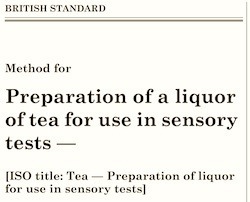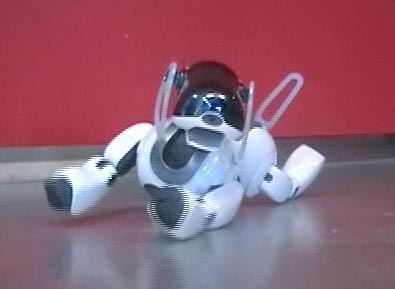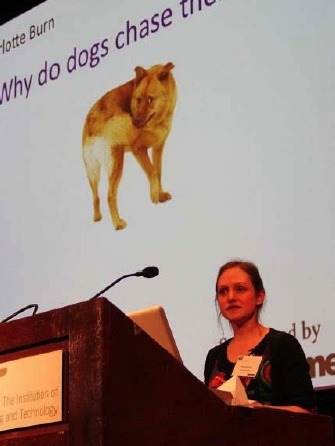Marc Abrahams's Blog, page 496
April 30, 2013
A cup of tea and some Smoots: One must or can celebrate standards
A core definition of Britishness, the official six-page specification for how to make a cup of tea, is officially “under review”. But don’t panic. It is standard procedure for the British Standards Institution (BSI) to do a “systematic periodic review” of each of its many specifications which, piecemeal, define nearly everything British.
 Belying stereotypes of peremptory rigidity in anyone or anything that officially tells the populace what’s what, the BSI is nice about what it does. “British Standards are voluntary in that there is no obligation to apply them or comply with them,” it says. The standards are “devised for the convenience of those who wish to use them”. That sentiment appears in the 44-page specification for standard number BS 0, “the standard that governs the way BSI produces standards”, copies of which are available free of charge.
Belying stereotypes of peremptory rigidity in anyone or anything that officially tells the populace what’s what, the BSI is nice about what it does. “British Standards are voluntary in that there is no obligation to apply them or comply with them,” it says. The standards are “devised for the convenience of those who wish to use them”. That sentiment appears in the 44-page specification for standard number BS 0, “the standard that governs the way BSI produces standards”, copies of which are available free of charge.
The cup-of-tea standard, officially numbered BS 6008, has been unchanged since 1980. It does come at a cost: £82 per copy, more than triple the £24 price, in effect, when I profiled it eight years ago….
—So begins this month’s Improbable Research column in The Guardian.
BONUS: The BSI was awarded the 1999 Ig Nobel Prize for literature, for BS 6008.
BONUS: A salute to Smoot.

April 29, 2013
A look back at the improbable show at the IET in London
Steve Colgan chronicled the recent Ig Nobel show at the Institute for Engineering and Technology, in London. This photo shows Dr. Charlotte Burn discussing what people make of the question of why dogs chase their tails. Colgan was one of the stars of the event, which was a featured part of this year’s Ig Nobel tour of the UK.
BONUS: Recorded video of the event.

April 28, 2013
Abusing robots – current positions [part 4 of 4]
Given that various groups of academic researchers (and others) are already investigating the torture of robots, and that these procedures raise ethical questions [See previous posts on this topic.] We now turn to the question of how robots might express the levels of ‘pain’ to which they are exposed. Clearly they must be able to do so in order for the torturer to appreciate the effects of his/her work. For answers we return to Dr. Christoph Bartneck (who co-organised the Milgram-esque experiment we described earlier.
 Along with colleagues Flip van den Berg, Carlijn Compen, Arne Wessel, and Bas Groenendaal, Dr. Bartneck produced a short video entitled ‘Cats & Dogs’ which showed AIBO ® and iCat ® which had been especially programmed to ‘express levels of pain’. The video, presented as part of the Proceedings of the 2nd ACM/IEEE International Conference on Human-Robot Interaction, can be viewed here [Quicktime .mov format may require browser plugin]
Along with colleagues Flip van den Berg, Carlijn Compen, Arne Wessel, and Bas Groenendaal, Dr. Bartneck produced a short video entitled ‘Cats & Dogs’ which showed AIBO ® and iCat ® which had been especially programmed to ‘express levels of pain’. The video, presented as part of the Proceedings of the 2nd ACM/IEEE International Conference on Human-Robot Interaction, can be viewed here [Quicktime .mov format may require browser plugin]
[Advisory : Not suitable for those with a sensitive disposition towards robots]
In the future, say the experimenters :
“Robots will not only need to be able to provide positive feedback, but also negative. This project explored the abilities of the robotic dog Aibo and the iCat robot to express pain. For two different robots 30 different levels of pain expressions were designed and tested. The results showed that participants are able to recognize small differences in pain expressions. The movie shows several representative expressions.”
Note : The Philips iCat ® should not be confused with the Sega iCat ®
BONUS: Dr. Bartneck is also author of The Unofficial LEGO® Minifigure Catalog.

Roy Armstrong joins hair club for scientists (LFHCfS)
Roy Armstrong has joined the Luxuriant Flowing Hair Club for Scientists (LFHCfS). Volker Deecke, who nominated him, says:
It is an honour as well as a pleasure to nominate Dr. Roy Armstrong. As you can see, his qualifications, both academic and follicular are impeccable.
Roy Armstrong, Ph.D, LFHCfS
Senior Lecturer
Centre for Wildlife Conservation
Newton Rigg Campus
University of Cumbria
Penrith, UK


The slow pitch of excitement
Robin McKie, in The Observer, chronicles the slowly, slowly, slowly mounting excitement about the Ig Nobel Prize-winning [physics prize, 2005] Australian pitch-drop experiment:
In terms of output, Queensland University’s pitch drop study – the world’s oldest laboratory experiment – has been stunningly low. Only eight drops have emerged from the lump of pitch installed in the university’s physics building foyer in 1927. Watching paint dry looks exhilarating by comparison.
But excitement is now rising over the experiment, which was set up to calculate the viscosity of the world’s stickiest substance, pitch, which has been found to be at least 230 billion times more viscous than water. According to Professor John Mainstone [pictured here], who has run the experiment since the 1960s, a ninth drop looks set to emerge from the pitch block in the very near future.
“No one has actually seen a drop emerge, so it is getting quite nervy round here,” said Mainstone. “The other eight drops happened while people had their backs turned….
(Thanks to investigator DK for bringing this report to our attention.)
You can and perhaps should watch the live webcam video of the experiment.
BONUS: A minor philosophy question to ponder: If one can hear a pin drop, can one hear a pitch drop?

April 27, 2013
Relative Value of Nature and Poetry (in Science)
Walter Westman wonders about worth:
“How Much Are Nature’s Services Worth?” Walter E. Westman, Science, vol. 197, no. 4307 (Sep. 2, 1977), pp. 960-964. The author, at UCLA, begins with a snippet of poetry from Wordsworth, then gets on with it:
‘To me the meanest flower that blows can give
Thoughts that do often lie too deep for tears.’ —WILLIAM WORDSWORTH
“Attempts to quantify nature’s services have heuristic value in providing perspective on the distance from both present estimates and a full accounting. Yet it is both sobering and im- portant to recognize that, even in the long run, quantitative estimates of the worth of nature to man are likely to remain asymptotic to the value expressed by the poet’s phrase.”
(Thanks to investigator Michael Strack for bringing this to our attention.)

April 26, 2013
Learning Quiz: The value of this beauty question
This week’s Learning-Quiz question: What, if anything, could the authors of this study possibly have hoped to learn from doing this study? The study is:
“What is beautiful is good, even online: Correlations between photo attractiveness and text attractiveness in men’s online dating profiles“, Rebecca J. Brand, Abigail Bonatsos, Rebecca D’Orazio, Hilary DeShong, Computers in Human Behavior, Volume 28, Issue 1, January 2012, pp. 166-170.
“Attractive people are considered by others to have many positive qualities and in the case of social skills and intelligence, these attributions are often true. In internet dating, individuals with attractive profile photos are viewed more favorably overall, but no research has yet established whether they indeed have more positive qualities. We addressed this issue by having 50 women independently rate 100 photos and free-written texts taken from males’ profiles on a popular dating website. Photos rated as physically attractive had profile texts that were rated as more attractive, even though photos and texts were rated by different judges.

Kenneth Appel, 4-color-map half-solver, has died
David Brooks reports, in his Granite Geek blog:
Kenneth Appel, famous for being part of the team that created the first great computer-aided proof, of the “four-color” theorem which says that any map can be colored with four colors without bumping colors against each other, and who later headed up the UNH math department, has died. He was 80.
Here’s an article I wrote about him and the proof for UNH Magazine in 2002.
The four-color proof was controversial because it dependend on a computer to crank through many possibilities as a demonstration that any possible map can be colored with just four colors without have any two adjacent shapes be the same color. It was the first major proof that couldn’t be totally understood by a human, and when released in 1976 (a time when mathematics still shunned computers as mere arithmetic tools) it drew howls of outrage….
An obituary appears in Appel’s local newspaper.
BONUS: Several years after the the proof was announced, I (under a pen name saluting one of my former math teachers) did a parody of it, with the headline “PROOF READERS’ UPDATE, JANUARY 1990: THE FOUR COLOR MAP THEOREM“.

A subject-specific model of human buttocks
Specific buttocks get a thorough analysis in this study:
“A subject-specific model of human buttocks and thighs in a seated posture,” , Matthew Reed, Gunther Paul, Gunther and , in 7th Australasian Congress on Applied Mechanics, ACAM 7, 9-12 December 2012, University of Adelaide, Adelaide, SA.
“MR image processing was conducted to both the left and the right sides of the model due to the intended asymmetric posture of the volunteer during the MR measurements. The presented subject-specific, three-dimensional model of the buttocks and thighs will add value to optimisation cycles in automotive seat development”
(Thanks to investigator Neil Martin for bringing this to our attention.)

April 25, 2013
Abusing robots – current positions [part 3 of 4]
Continuing our observation of inquiries into the torture of robots, we now turn to the ethical questions raised (by some). Kate Darling – who presented the recent ‘Robotic Dinosaur Abuse Workshop’ in Geneva, examines such questions in a paper entitled – Extending Legal Rights to Social Robots - (presented at the We Robot Conference, University of Miami, April 2012). In which the author points out that:
“Not long after the Pleo robot dinosaur became commercially available in 2007, videos of Pleo ‘torture’ began to circulate online.”
Here is an example cited in the paper [ Advisory : Not suitable for Pleophiles or those of a sensitive disposition towards robots]
“The typical debate surrounding ‘rights for robots’ assumes a futuristic world of fully autonomous and highly sophisticated androids that are nearly indistinguishable from humans. While technological development may someday lead to such a Blade Runner-esque scenario, the future relevant legal issues are currently shrouded by unforeseeable factors.”
“At this point, it is uncertain what types of technological developments will occur in what order, as well as what tangential legal structures will be in place at that time.”
“This arguably places most legal discussions of ‘robot rights’ in the entertaining rather than scientific or pragmatic realm.”
“Partly explaining why some describe those of us who engage in such discussion as ‘crazy’ ”
Note: A pdf of the full paper may be downloaded via its link above.
COMING SOON : Robots feel the pain

Marc Abrahams's Blog
- Marc Abrahams's profile
- 14 followers




